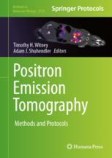Search
Search Results
-
Single-Cell PET Imaging and Tracking
Positron emission tomography (PET) is one of the most sensitive whole-body molecular imaging techniques available in the clinic, able to detect...
-
Quantitation of Oncologic Image Features for Radiomic Analyses in PET
Radiomics is an emerging and exciting field of study involving the extraction of many quantitative features from radiographic images. Positron...
-
11C-Fixation Techniques
This protocol describes the application of cyclotron-generated [11C]CO2 fixation reactions for direct 11C-carboxylation reactions and [11C]CO for...
-
Characterization and Validation of Radiotracer Kinetics Using the Langendorff Isolated Perfused Heart
The Langendorff isolated perfused heart is a physiologically relevant and controllable ex vivo model well suited to characterizing and validating...
-
Rapid Radiolabeling for Peptide Radiotracers
Peptide-based radiopharmaceuticals (PRPs) have been developed and introduced into research and clinic diagnostic imaging and targeted radionuclide...
-
CRISPR/Cas for PET Reporter Gene Engineering
The relatively recent discovery of CRISPR/Cas has led to a revolution in our ability to efficiently manipulate the genome of eukaryotic cells. We...
-
Brain PET Imaging in Small Animals: Tracer Formulation, Data Acquisition, Image Reconstruction, and Data Analysis
Positron emission tomography (PET) is a noninvasive functional imaging modality that involves in vivo detection of spatiotemporal changes in the...
-
Multiplexing Autoradiography
Autoradiography, the direct imaging of radioactive distribution in tissue sections, is a powerful technique that has several key advantages for the...
-
Silicon–Fluoride Acceptors (SiFA) for 18F-Radiolabeling: From Bench to Bedside
Fluorine-18 (18F) is undoubtedly one of the most frequently applied radionuclides for the development of new radiotracers for positron emission...
-
Methods for the Production of Radiolabeled Bioagents for ImmunoPET
Immunoglobulin-based positron emission tomography (ImmunoPET) is making increasingly significant contributions to the nuclear imaging toolbox. The...
-
Radiolabeled Affibody Molecules for PET Imaging
Owing to their ease of engineering and production, chemical stability, size, and high target affinity and specificity, radiolabeled affibody...
-
Preparation of [68Ga]GaCl3 Using a Cyclotron
Recent developments in 68Ga-radiopharmaceuticals, including a number of regulatory approvals for clinical use, has created a hitherto unprecedented...
-
Combined PET/MR: Where Anatomical Imaging Meets Cellular Function
Recent technological advances in medical imaging have allowed for both sequential and simultaneous acquisition of magnetic resonance imaging (MRI)...
-
Imaging the Tumor Antioxidant Response with [18F]FSPG PET
(4S)-4-(3-[18F]Fluoropropyl)-L-glutamic acid ([18F]FSPG) is a flourine-18 labeled glutamate analog that enables the noninvasive in vivo imaging of...
-
Practical Considerations for Total-Body PET Acquisition and Imaging
The world’s first total-body PET/CT system has been in routine clinical and research use at UC Davis since 2019. The uEXPLORER total-body PET scanner...
-
Genetic Engineering of Therapeutic Cells with the Sodium Iodide Symporter (NIS) to Enable Noninvasive In Vivo Therapy Tracking
Noninvasive long-term imaging of therapeutic cells in preclinical models can be achieved through introducing a reporter gene into the cells of...
-
Radiosynthesis of [18F]FPenM-C2Am: A PET Imaging Agent for Detecting Cell Death
Imaging agents capable of detecting the extent, timing, and distribution of tumor cell death following treatment could be used in clinical trials of...
-
Kinetic Modeling Methods in Preclinical Positron Emission Tomography Imaging
There is an expanding number of applications for preclinical positron emission tomography (PET) imaging. Kinetic modeling of PET data provides rich...
-
Enantioselective Synthesis of Carbon-11-Labeled Amino Acids and Peptides
Radiolabeled amino acids (AAs), their derivatives, and peptides are essential radiotracers in nuclear imaging. Despite its potential, the preparation...
-
PET System Technology: Theoretical Aspects and Experimental Methodology
Positron emission tomography (PET) imaging provides unique information of the cellular and molecular pathways of disease occurring within the human...
